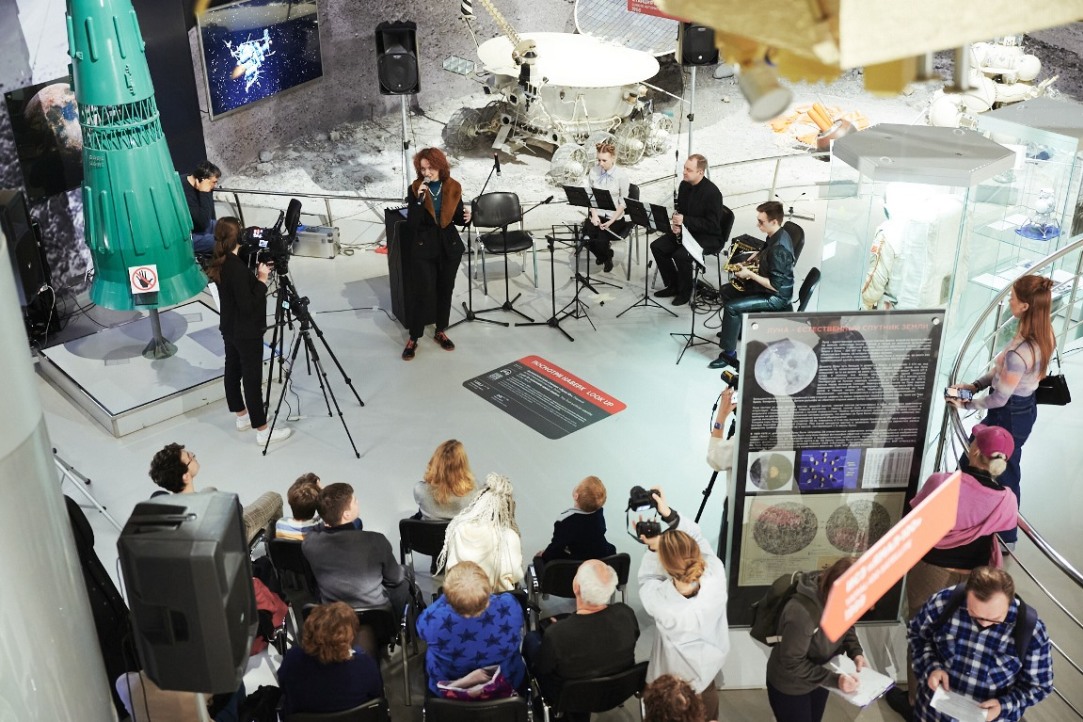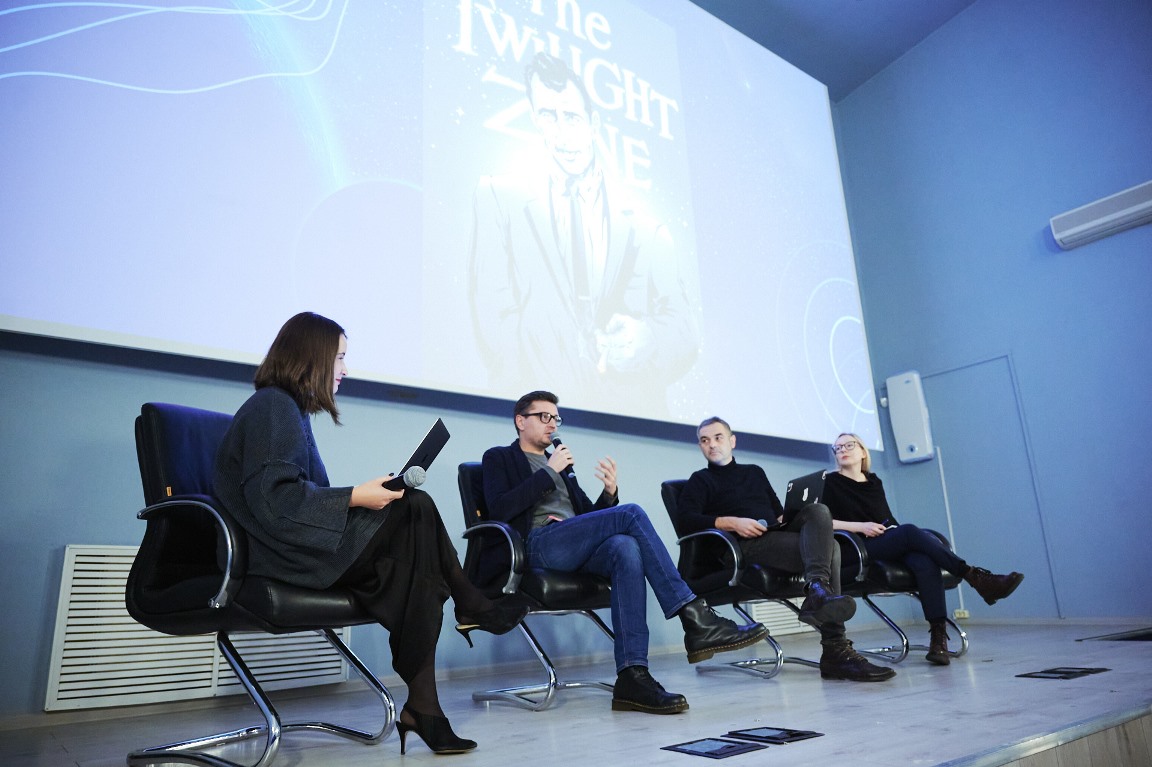'In Outer Space, Encounters between Humans and Non-humans Could be in a Variety of Languages'

On November 5, the Museum of Cosmonautics in Moscow hosted an HSE-organised event entitled 'Cosmic Bodies: A Philosophical and Musical Party for Cyborgs'. The speakers and the audience reflected on popular-culture depictions of humans as they explore outer space.
The event was co-organised by the HSE Faculty of Creative Industries, its projects 'Space in Media Culture' and 'Posthumanism(s) in Media Culture and Contemporary Art', and HSE's Media Sharks music label.
Evgenia Nim, associate professor of the HSE Institute of Media, explained how the event got its title of ‘Cosmic Bodies’. 'In space science, cosmic bodies are physical objects that naturally occur in the observable universe, for example, comets, asteroids, planets, stars, and galaxies. But we are using this term in a broader sense as a metaphor for any type of intelligent cosmic entity,' she said. According to Nim, this metaphor can lead to a more productive discussion about humanity's potential future in outer space.
The party featured a futuristic, space-themed digital fashion show created by students of HSE's Art and Design School as part of the project 'Space in Media Culture'. Virtual cyborg models walked on an 'extra-terrestrial' stage dressed in garments of uncommon textures and styles.
The show was followed by a philosophical discussion moderated by Natalia Vereshchagina, visiting lecturer of the HSE Institute of Media. The speakers reflected on the concept of humans (and non-humans) in space using popular film characters as examples. Alexander Pavlov, professor at the HSE School of Philosophy and Cultural Studies, explored the theme through the prism of The Twilight Zone series. He discussed how this early 1960s programme addressed the issues of post-colonisation with reference to outer space: 'We must find ways to make peace and stay friends; there may be intelligent beings out there who wish to contact or colonise us. This is one of the things posthumanism is all about: changing not only our language, but our way of thinking.'

Panos Kompatsiaris, assistant professor at the HSE Institute of Media, referred to 2001: A Space Odyssey by Stanley Kubrick and The Martian by Ridley Scott, as well as to Elon Musk's interplanetary project. These stories of space exploration and the role of humans in this process are highly popular in contemporary media culture. 'Outer space is depicted as territory that must support human life, including by providing the right atmosphere and material resources such as water, soil, and minerals,' Kompartsiaris said. 'These resources must lend themselves to human impact, so they may be transformed and used for the reproduction of human life.'
In the finale of the discussion, Chang Li, Master's student of the HSE Critical Media Studies programme, presented her own musical performance about outer space and humans' place in it, featuring a conversation between the captain of a time machine and a passenger about to be transported to an immortal future. They discuss the human dimension of a future where people will get new bodies and no one will ever die.
According to Nim, 'In the context of space exploration, human transformation and encounters between humans and non-humans can be discussed using a variety of languages not limited to the languages of philosophy or media, but also in the language of music. Music can generate special feelings and a kind of experience that words are unable to convey. Music is one of the best ways to reflect on something that falls outside the limits of human reason.'
The Cosmic Bodies event closed with a specially prepared concert by two musical groups. The HSE Design Orchestra led by Petr Skovorodnikov premiered two electro-acoustic compositions by Evgenia Evpak: Random UFO, a five-part sinfonietta, and Voice of Reason, an experimental piece created from audio recordings of the event speakers' presentations. Both compositions will be published under HSE's Media Sharks label in December 2022. Visitors to the Museum of Cosmonautics could also hear a number of musical compositions, including variations on some of Dvar Band's hits, performed by GAMEnsemble led by Oleg Paiberdin.
See also:
HSE, University of Delhi, and Geoscan Launch Space Research Project
HSE University and the University of Delhi (India), in partnership with Geoscan (a portfolio company of the Innopraktika non-state development institute), have agreed to establish an international scientific mirror laboratory on data storage, processing, and transmission in space systems. The agreement was signed on January 15, 2025, during a visit to India by an HSE University delegation led by Rector Nikita Anisimov.
‘An Avatar Is an Image of a Posthuman’: Mediacosm Held at HSE University
On February 16, the sixth Mediacosm conference was held. The event traditionally dedicated to discursive and non-discursive ways of presenting the cosmos through media, fashion and music was organised by the HSE Faculty of Creative Industries.
Scientists Learn to Better Predict Space Weather
An international team of astrophysicists has been studying the formation of strong electrostatic waves, ion holes, in the Earth's magnetotail and assessing their impact on space weather. They found that ion holes propagate oblique to the local magnetic field. The study's findings can contribute to a better understanding of processes in the Earth's magnetotail which affect space weather in the near-Earth plasma environment and the polar region. The paper is published in Geophysical Research Letters.
HSE University Participates in Satellite Navigation Monitoring Project
A team of HSE students is taking part in the development of a Russian satellite automatic identification system (AIS) to monitor sea navigation. The aim of the project is to track the locations of vessels and adjust their routes, including in the Arctic along the Northern Sea Route.
Researchers Explain Potential Cause of Earth’s Green Airglow
A team of Russian researchers from HSE University, the Russian Space Research Institute, and the Pushkov Institute of Terrestrial Magnetism (Russian Academy of Sciences) has described the development of modulational instability of electromagnetic waves in dusty ionospheric plasma, which is caused by a high intensity of electromagnetic emissions. The researchers considered inelastic collisions of ionospheric plasma particles and formulated new tasks and applications to be addressed at a later stage. The results are published in the Physics of Plasmas journal.
‘The Trip to Baikonur Blew My Mind!’
On Cosmonautics Day, the HSE News Service spoke with the participants of the CubSX-HSE project, which recently launched a satellite into Earth orbit. Students and staff from the HSE Moscow Institute of Electronics and Mathematics (MIEM) spoke about their project and impressions of their trip to Baikonur.
‘Now I Will Pursue a Future Career in Space’
During the ‘Big Challenges’ session at the Sirius Educational Centre, five high school students, under the supervision of mentors from MIEM HSE, assembled a small artificial earth satellite. The participants of the research session were young finalists of a nationwide competition held by the educational centre. All five of the students are Olympiad champions and team members of large-scale projects.
Russian Scientists Discover One of the Mechanisms of Water Formation on the Moon
The results of recent study conducted by the NASA Lunar Reconnaissance Orbiter, the agency’s automatic interplanetary station, show the existence of a ‘permafrost’ near the poles of the Moon with a relatively high content of water ice (up to 5% by weight). It is believed that water ice could supply a life support system for the future Russian Lunar Station and that it could also produce hydrogen-oxygen fuel for flights into deep space.
Researchers Determine Space Weather near Earth’s Closest Exoplanet
Researchers from the Higher School of Economics and Space Research Institute (Russia) have calculated the main parameters that determine space weather close to the nearest Earth-like exoplanet, Proxima Centauri b. Such parameters include solar wind, as well as galactic and solar cosmic rays. The results of the research were published in Astronomy Letters.
Not Getting Lost in Space: Why It’s Important to Learn to Detect Signals from Neutron Stars
The big scanning antenna at the Pushchino Radio Astronomy Observatory logs almost 90 GB of data every day. The data are usually processed by the astronomers manually. Vladimir Samodurov and Alexander Gorbunov, researchers at the HSE Faculty of Business and Management, decided to relieve the scholars from this hard work and give this job to neural networks. They shared the results of their work in the paper ‘Perspectives of intellectual processing of large volumes of astronomical data using neural networks’.


